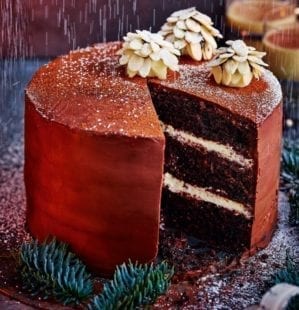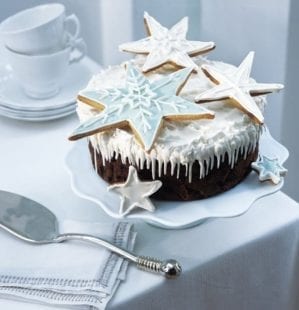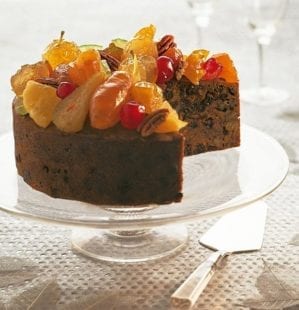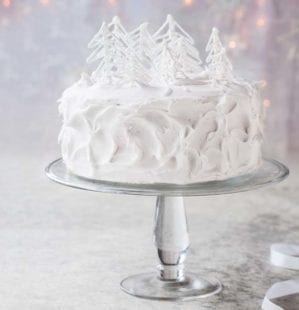
Rick Stein’s Christmas cake
- Published: 16 Nov 21
- Updated: 25 Mar 24
Rick Stein’s recipes never fail to deliver and his Christmas cake is no exception. Follow Rick’s step-by-step recipe for a classic iced cake.
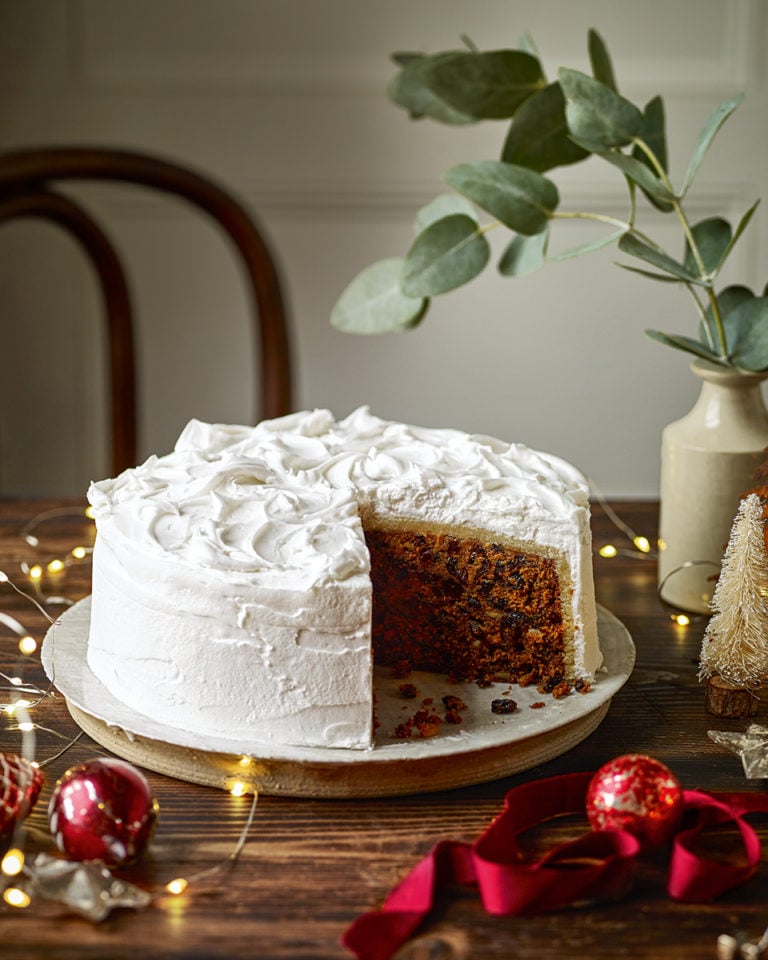
Rick Stein at Home (BBC Books; £26) is out now.
-
Serves 12-16
-
Hands-on time 45 min, plus overnight soaking and cooling – then, later, overnight drying of the marzipan and icing
Ingredients
- 175g sultanas
- 275g currants
- 175g raisins
- 50g glacé cherries, halved
- 50g mixed peel
- Grated zest 1 orange
- Grated zest 1 lemon
- 75ml brandy or sherry, or orange juice if you prefer
- 225g butter, softened
- 225g dark muscovado sugar
- 4 medium free-range eggs, beaten
- 225g plain flour
- 60g chopped mixed nuts or ground almonds
- 1 tsp mixed spice
- ¼ tsp freshly grated nutmeg
- Brandy, sherry, port or rum for feeding (optional)
For the marizpan
- 250g ground almonds
- 125g icing sugar, plus extra for dusting
- 125g caster sugar
- 1 tsp almond extract
- 1 medium free-range egg white
- 2-3 tbsp apricot jam, warmed and sieved
For the royal icing
- 3 medium free-range egg whites
- 675g icing sugar, sifted
- 1½ tsp glycerine (see Know How)
- 1-2 tsp lemon juice
- 1 drop blue food colouring (optional; see Know How)
You’ll also need
- 20cm round deep-sided cake tin, fully lined (see tips for how to line the Christmas cake tin)
Method
- The day before you make your cake, mix the dried fruit, cherries and peel with the citrus zest. Stir in the brandy, sherry or orange juice, cover and leave to soak overnight.
- Heat the oven to 120°C fan/gas 1 and line your cake tin (see tips). Using a stand mixer fitted with the beater or electric hand mixer, beat together the butter and sugar until well combined and fluffy (3-4 minutes). Add the beaten eggs, a little at a time. If the mixture starts to look as though it’s curdling, add 1 tbsp of the measured flour, then continue to add the eggs. Stir in the remaining flour, chopped nuts, spices and the soaked dried fruit along with any unabsorbed liquid.
- Spoon the mixture into the prepared tin and flatten the surface. Cover the top with a double layer of baking paper and cut a 4cm wide disc out of the middle to allow steam to escape. Bake the cake on the lowest shelf of the oven for 4 hours and 15 minutes. Test with a skewer pushed into the middle of the cake; if it comes out clean, remove the cake and put it on a wire rack. If not, put the cake back in the oven for another 15 minutes and check again – until a skewer comes out clean (apart from any fruit). Take the cake out of the tin and leave to cool completely on a wire rack.
- If you’re making the cake weeks in advance, store in an airtight container. To feed it, several times a week, skewer holes in the surface and add a few teaspoons of brandy, sherry, port or rum. If you’re not storing it, you can cover the cake with marzipan as soon as it’s cold.
- Make the marzipan up to 2 days before icing: combine all the ingredients, except the jam, in a food processor and pulse until combined. Turn out on to a board dusted with icing sugar and knead briefly to form a dough, then wrap well or store in a plastic box in the fridge until ready to use.
- To marzipan the cake, measure up the side of the cake, across the top and down the other side to get a diameter for your disc of marzipan. Roll it out on a board dusted with icing sugar until large enough to cover the cake. Brush the cake all over with the warmed apricot jam. Drape the marzipan over a rolling pin and line up the centre of the marzipan with the centre of the cake. Place the marzipan over the cake and down the sides. Smooth it over from the centre outwards and trim off any excess. Cover with a clean tea towel and leave to dry out for at least 24 hours and up to a week in a cool dry place.
- Next, make the icing: briefly beat the 3 egg whites in a bowl using an electric hand whisk – they should be frothy, not stiff. Add enough of the sifted icing sugar, a little at a time, until you have a thick paste (at least 500g, but you may not need all the icing sugar). Whisk for 10 minutes or so until the icing is whipped and shiny. Add the glycerine, then 1 tsp of the lemon juice and the blue colouring, if using (see Know How). The icing should be glossy and stand in stiff peaks. Add a little more lemon juice if it’s too stiff to work with.
- Pile the icing on top of the marzipanned cake and use a palette knife to swirl over the top and sides so it looks like a rough snow scene – use the palette knife or a fork to create texture. Leave to dry overnight, then add a ribbon and any other festive decorations you want to.
- Recipe from November 2021 Issue
Nutrition
- Calories
- 686kcals
- Fat
- 24.5g (8.7g saturated)
- Protein
- 10.3g
- Carbohydrates
- 102.6g (87.9g sugars)
- Fibre
- 1.8g
- Salt
- 0.4g
delicious. tips
How to line the Christmas cake tin: Cut 2 discs of baking paper to fit the base, then cut a length of baking paper 10cm longer than the circumference of the tin and 5cm taller than the tin depth. Along the long edge, fold over a strip 2cm wide, then snip along the folded edge every 2cm. Butter the tin well and lay a disc of baking paper in the base. Then line the sides of the tin with the long strip of baking paper, fitting the snipped edge into the base so it rests on the baking paper and pressing the fold into the edges of the tin. Add the second disc to the base, covering the snipped edges, then brush it all with a little vegetable oil. The tin is now ready to use.
Learn how to marzipan a cake below…
The cake will keep for several weeks if you ‘feed’ it. Make the marzipan and cover the cake at least a day before icing.
Easy swaps: If not eating the cake within a few days of icing, use pasteurised egg whites instead of fresh in the royal icing. You’ll find them in the chilled aisle of larger supermarkets.
The addition of glycerine to royal icing prevents it setting rock hard when dry. The optional blue food colouring cancels out any yellow colour in the icing, giving an extra-white finish.
Buy ingredients online
Rate & review
Rate
Reviews
Subscribe to our magazine
Food stories, skills and tested recipes, straight to your door... Enjoy 5 issues for just £5 with our special introductory offer.
Subscribe
Unleash your inner chef
Looking for inspiration? Receive the latest recipes with our newsletter

